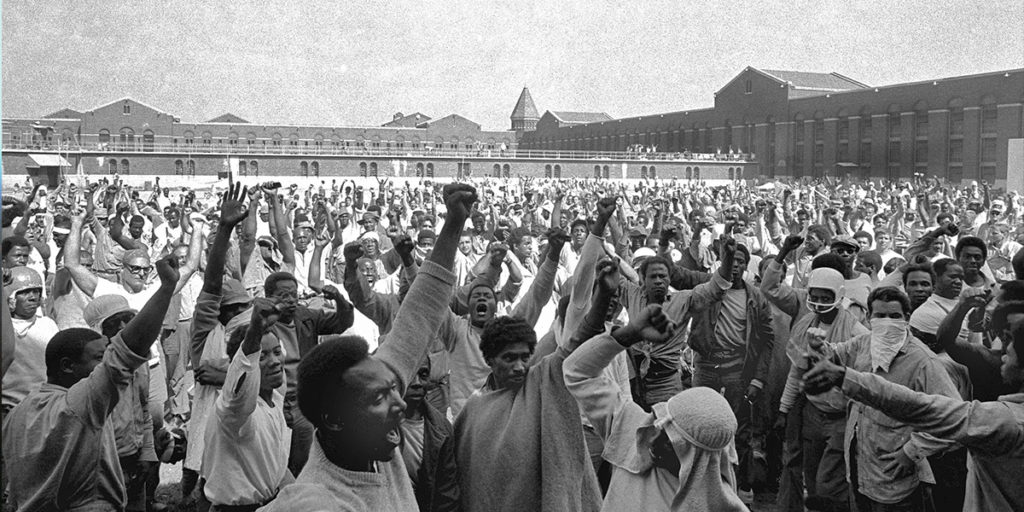Attica

Image courtesy TIFF.
“We are men! We are not beasts and we do not intend to be beaten or driven as such. The entire prison populace, that means each and every one of us here, have set forth to change forever the ruthless brutalization and disregard for the lives of the prisoners here and throughout the United States. What has happened here is but the sound before the fury of those who are oppressed. We will not compromise on any terms except those terms that are agreeable to us. We’ve called upon all the conscientious citizens of America to assist us in putting an end to this situation that threatens the lives of not only us, but of each and every one of you, as well.”
– Declaration to the People of America, Read by Elliott James “L.D.” Barkley, September 9, 1971
On September 9, 1971, inmates at Attica Correctional overtook the facility, staged an uprising, and demanded basic rights to which they’re entitled under the Eighth Amendment. State Troopers under Governor Rockefeller’s authority massacred thirty-nine in total, of which nine were hostages. Prior to their autopsies, the Governor and Commissioner of Corrections Russell Oswald claimed prisoners slew the hostages. In fact, all were shot with high caliber ammunition fired from the State troopers’ rifles.
Directed by Stanley Nelson, ATTICA combines a trove of historical footage, prison surveillance footage, and interviews with former prisoners, the families of guards, journalists and members of the observer committee requested by inmates to assist with negotiations. While white prisoners could get away with extra meals and lighter punishments, corrections officers regularly assaulted Blacks and Hispanics, denied Black Muslims their right to prayer and forced them to eat pork.
“You had all white guards, a population of prisoners that was 70 or more percent black or brown. What could go wrong?” deadpans lawyer Joe Heath. Attica is a small town whose population, almost entirely white, was at the time employed almost exclusively by the prison. Jaime Valone, son of a prison guard held hostage, confesses, “I was scared for my dad. I loved my dad, but we didn’t really know what was going on.”
Inside the walls of Attica, figures like George Jackson, who received a life sentence for armed robbery over a ten dollar bill, L.D. Barkley, and Bobby Seale, served as lightning rods for the movement. The murder of Jackson by corrections officers brought the prisoners at Attica together in solidarity. Shrewdly, they allowed in journalists including WABC’s John Johnson. This immediately exposed to the world the conditions at Attica, and, the documentary argues, changed the power dynamic.
Jerry Rosenberg, a convicted murderer, “grandstanded” over the injunction acquired by Herman Schwartz, a professor of law from the University of Buffalo who’d agreed to represent the inmates. Rosenberg’s posturing over the omission of the State Seal—which Schwartz notes isn’t required to give a signed court order the force of law—cost the inmates a critical opportunity to bring the standoff to an end. Several inmates express frustration at the fact that Rosenberg overplayed a hand so rarely held by a predominantly Black prison population seeking criminal justice reform.
Nelson’s images largely speak for themselves, and some cursory research proves out most of the assertions in the film. Unearthed from the Nixon tapes, dialogues between the former President who resigned in disgrace and the ambitious Governor, trying to position himself as “tough on crime,” reveal that the so-called law and order is just doublespeak for white supremacy. Officers are heard shouting racial epithets as they herd Black prisoners stripped bare. At one point Nixon asks Rockefeller if any white people were harmed or killed. When Rockefeller assures him all the people killed were Black, Nixon says, “We just cannot tolerate this kind of anarchy.”
When the National Guard came to clean up the carnage left by the State Troopers, their Colonel told them not to discuss with anyone what they saw.
Lewis Steel, an attorney for the NAACP and a member of the observer committee at Attica, concludes, “It should have ended in a negotiated settlement. No, they weren’t interested in that. They were interested in showing the naked fist of power.”
Of the $20 million in settlements reached in 2005, thirty-four years after the fact, many prisoners received amounts as little as $6500. No state official ever issued a formal apology to the families of the ten hostages killed by law enforcement. No officers were charged with any crimes. While the events at Attica did lead to some reforms, two decades of reversals followed—privatization exploiting the Thirteenth Amendment loophole, President Clinton’s famous “three strikes” policy, and the increased militarization of law enforcement. The prison population of New York grew 880 percent from 1971 to 1999.